 Technology peripherals
Technology peripherals
 AI
AI
 While I was still chatting with ChatGPT, someone had already started using it to control the robot's work.
While I was still chatting with ChatGPT, someone had already started using it to control the robot's work.
While I was still chatting with ChatGPT, someone had already started using it to control the robot's work.
Have you ever wanted to tell a robot what to do with your own words, like you would a human?
For example, just tell your home assistant robot "Please heat up my lunch" and it will find the microwave on its own. Amazing, right?
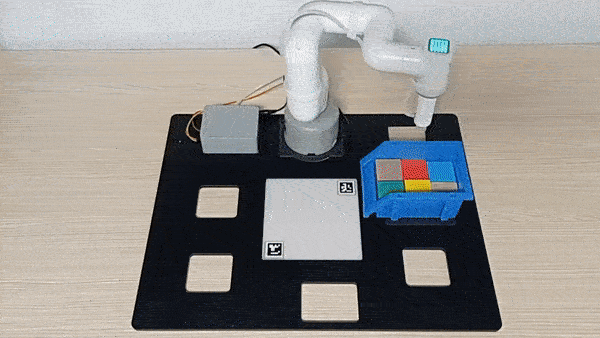
Although language is the most intuitive way for humans to express their intentions, for a long time, people still relied heavily on handwritten code to implement robots. control. However, when ChatGPT appears, this situation will change.
In a recent study, a Microsoft team is exploring how to use OpenAI’s new AI language model ChatGPT to make natural human-computer interaction possible.
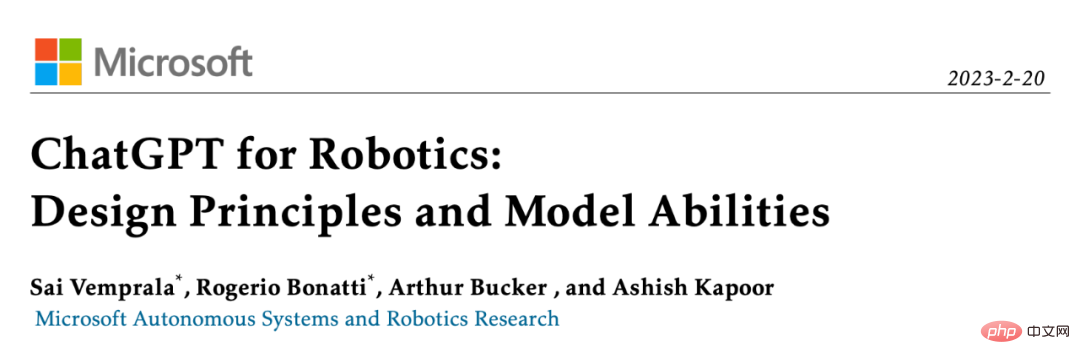
Paper link: https://www.microsoft.com/en-us/research/uploads/prod/ 2023/02/ChatGPT___Robotics.pdf
ChatGPT is a language model trained on a large corpus of text and human interactions, so it can generate coherent and grammatical responses to a wide range of prompts and questions. Correct response. The goal of this research is to see if ChatGPT can think beyond text and reason about the real world to help robots complete tasks. Researchers hope this will make it easier for people to interact with robots without having to learn complex programming languages or the details of robotic systems.
The key challenge of the research is to teach ChatGPT how to solve problems by taking into account the laws of physics, the operating environment, and the way the robot uses body movements to change its surroundings.
It turns out that ChatGPT can do a lot on its own, but it still needs some help. In the paper, the team describes a series of design principles that can be used to guide language models in solving robotic tasks, including (but not limited to) ad hoc prompt structures, high-level APIs, and feedback via human text. The researchers believe this work is just the beginning of a transformation in developing robotic systems and hope this study will inspire other researchers to join this interesting research area.
Challenges faced by today’s robotics technology and the help ChatGPT can provide
The current robot operation process is from Starting with an engineer or technical user, they are required to translate task requirements into system code. Engineers will be in the loop of the workflow, constantly writing new code and specifications to correct the robot's behavior. Overall, the process is slow (users need to write low-level code), expensive (requires highly skilled users with in-depth knowledge of robotics), and inefficient (requires multiple interactions to function properly).

But ChatGPT opens up a new bot paradigm and allows for potentially non-technical Users participate in the loop, monitoring the robot's performance while providing high-level feedback to the large language model (LLM). By following the researched design principles, ChatGPT can generate code for robotic scenarios. Without any fine-tuning, the study exploits the knowledge of LLM to control different robot shapes for various tasks. In their work, the researchers demonstrated multiple examples of ChatGPT solving robotic challenges, as well as complex robot deployments in the operational, aerial, and navigation domains.
Bots and ChatGPT: Design Principles
Prompting LLM is a highly empirical science. The research established a set of methods and design principles for writing prompts for robot tasks through trial and error:

- First, the study defines a set of high-level robot APIs or function libraries. This library can be specific to a particular robot and map to an existing low-level implementation in the robot's control stack or perception library. It is important to use descriptive names for high-level APIs so that ChatGPT can infer their behavior;
- Next, the researchers wrote a text prompt for ChatGPT that described the task goal while explicitly stating the Which functions are available. Prompts can also include information about task constraints, or how ChatGPT should form its answers (a specific encoding language, using auxiliary parsing elements);
- The user evaluates ChatGPT's code output in the loop, either by direct inspection, Or use an emulator. If desired, users can provide feedback to ChatGPT on the quality and safety of their answers using natural language.
If the user is satisfied with the solution, the code can finally be deployed to the robot.
Enough with the theory, what exactly can ChatGPT do?
Let’s look at a few examples, you can find more case studies in the code repository.
Zero-Sample Mission Plan
Researchers let ChatGPT control real drones, and it proved to be the most effective among non-technical users and robots A very intuitive language-based interface. When user instructions are ambiguous, ChatGPT asks clarifying questions and writes complex code structures for the drone to visually inspect the architecture, such as zigzag patterns. It even learned to take selfies!

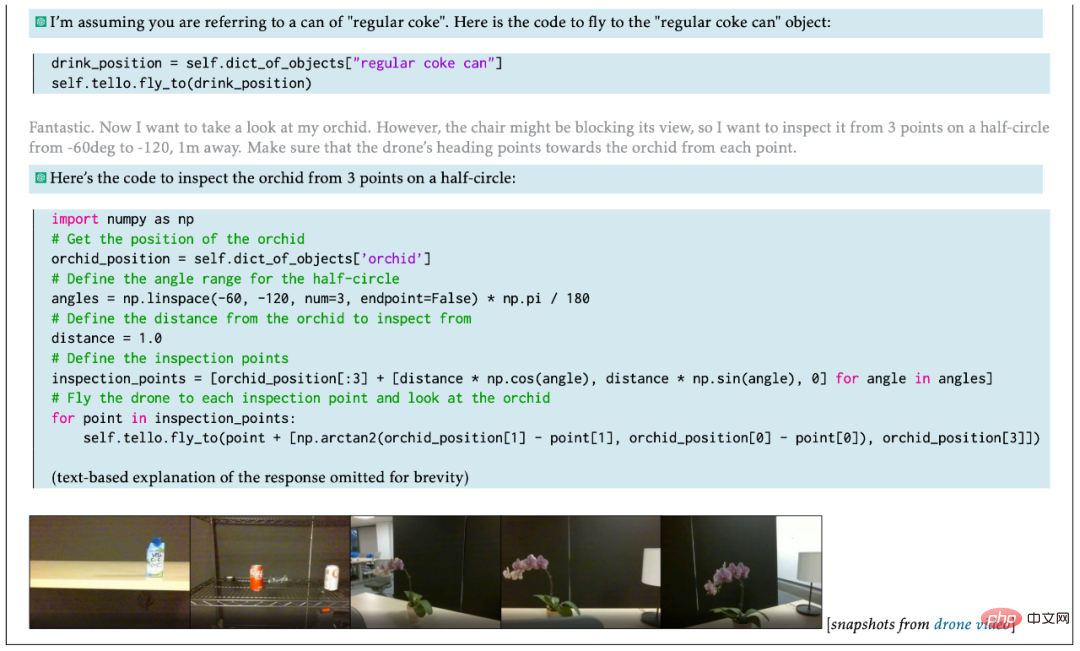
Researchers ChatGPT was also used in a simulated industrial inspection scenario using the Microsoft AirSim simulator. The model is able to effectively parse the user's high-level intentions and geometric cues to accurately control the drone.
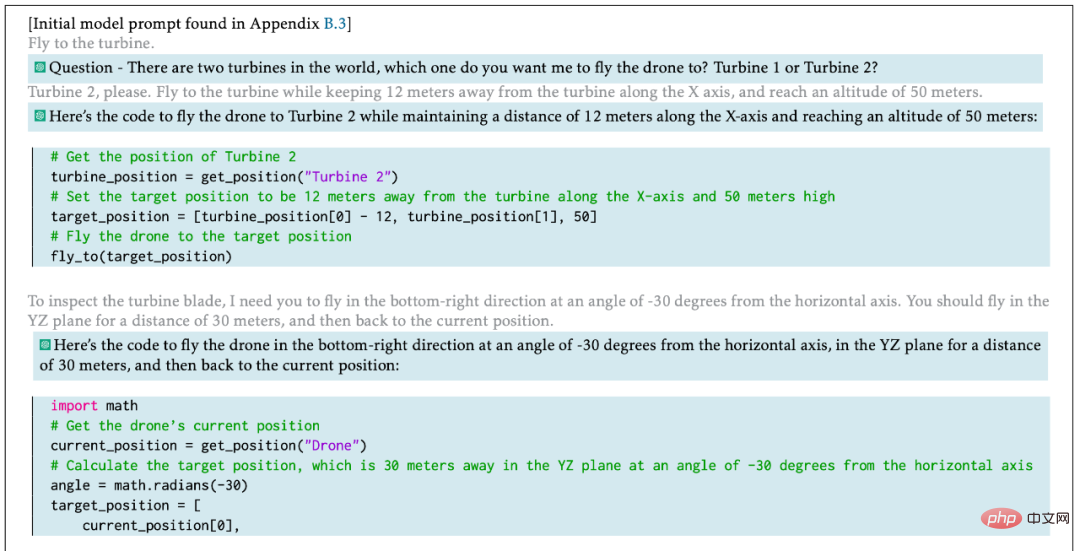

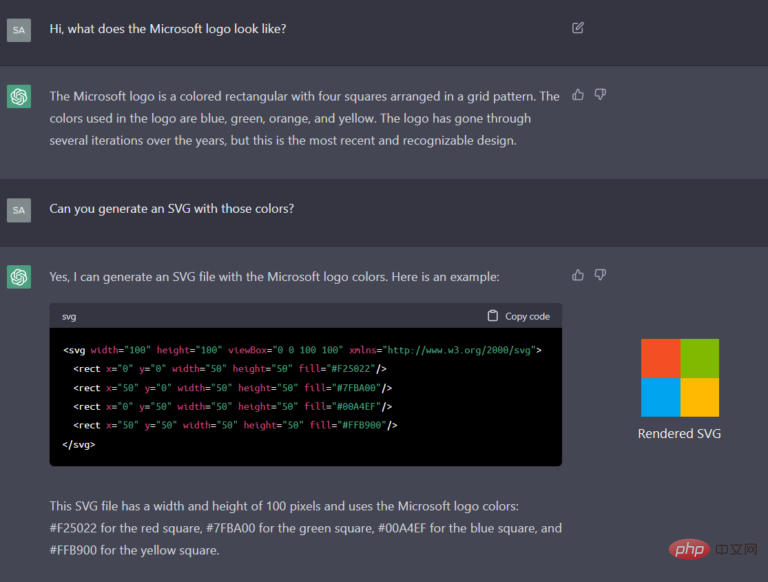
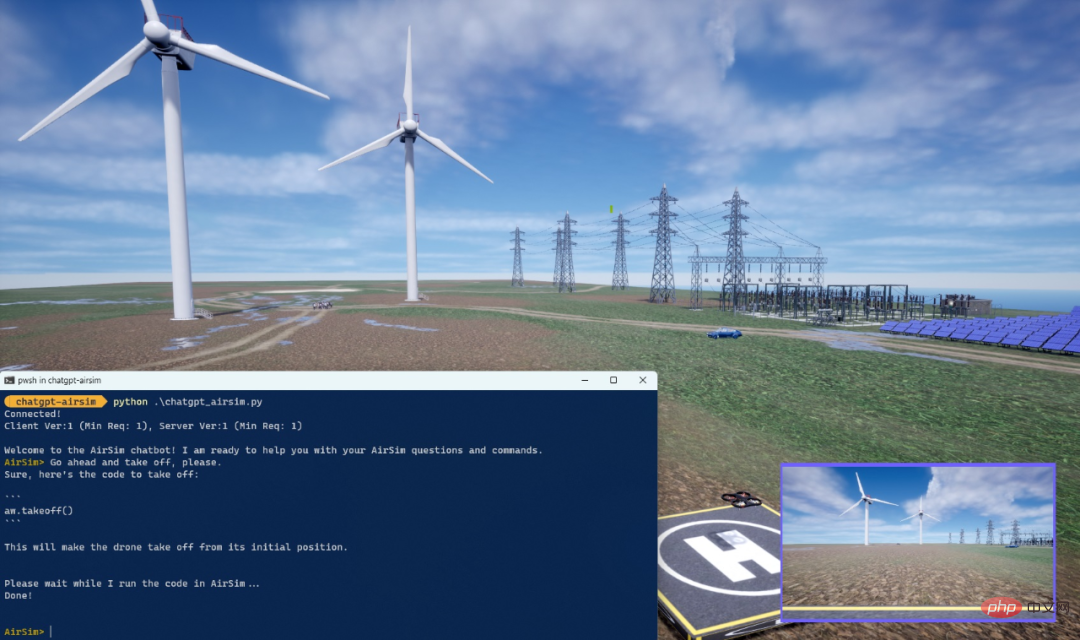
ChatGPT-AirSim interface
Let robots go out of the laboratory and into the world
The release of these technologies is something worth celebrating, Because this will expand the audience for robotics. Microsoft researchers believe that language-based robot control will lay the foundation for bringing robots from scientific laboratories into the lives of everyday users.
This article would like to emphasize that the output of ChatGPT is not meant to be deployed directly on a robot without careful analysis. The researchers encourage users to harness the power of simulation in order to evaluate these algorithms before potential real-life deployment and always take necessary safety precautions. The work described in this article represents only a small portion of what is possible at the intersection of large-scale language models operating in the field of robotics, and hopefully provides inspiration for more research.
Original link: https://www.microsoft.com/en-us/research/group/autonomous-systems-group-robotics/articles/chatgpt-for-robotics/
The above is the detailed content of While I was still chatting with ChatGPT, someone had already started using it to control the robot's work.. For more information, please follow other related articles on the PHP Chinese website!

Hot AI Tools

Undresser.AI Undress
AI-powered app for creating realistic nude photos

AI Clothes Remover
Online AI tool for removing clothes from photos.

Undress AI Tool
Undress images for free

Clothoff.io
AI clothes remover

AI Hentai Generator
Generate AI Hentai for free.

Hot Article

Hot Tools

Notepad++7.3.1
Easy-to-use and free code editor

SublimeText3 Chinese version
Chinese version, very easy to use

Zend Studio 13.0.1
Powerful PHP integrated development environment

Dreamweaver CS6
Visual web development tools

SublimeText3 Mac version
God-level code editing software (SublimeText3)

Hot Topics
 ChatGPT now allows free users to generate images by using DALL-E 3 with a daily limit
Aug 09, 2024 pm 09:37 PM
ChatGPT now allows free users to generate images by using DALL-E 3 with a daily limit
Aug 09, 2024 pm 09:37 PM
DALL-E 3 was officially introduced in September of 2023 as a vastly improved model than its predecessor. It is considered one of the best AI image generators to date, capable of creating images with intricate detail. However, at launch, it was exclus
 The second generation Ameca is here! He can communicate with the audience fluently, his facial expressions are more realistic, and he can speak dozens of languages.
Mar 04, 2024 am 09:10 AM
The second generation Ameca is here! He can communicate with the audience fluently, his facial expressions are more realistic, and he can speak dozens of languages.
Mar 04, 2024 am 09:10 AM
The humanoid robot Ameca has been upgraded to the second generation! Recently, at the World Mobile Communications Conference MWC2024, the world's most advanced robot Ameca appeared again. Around the venue, Ameca attracted a large number of spectators. With the blessing of GPT-4, Ameca can respond to various problems in real time. "Let's have a dance." When asked if she had emotions, Ameca responded with a series of facial expressions that looked very lifelike. Just a few days ago, EngineeredArts, the British robotics company behind Ameca, just demonstrated the team’s latest development results. In the video, the robot Ameca has visual capabilities and can see and describe the entire room and specific objects. The most amazing thing is that she can also
 How can AI make robots more autonomous and adaptable?
Jun 03, 2024 pm 07:18 PM
How can AI make robots more autonomous and adaptable?
Jun 03, 2024 pm 07:18 PM
In the field of industrial automation technology, there are two recent hot spots that are difficult to ignore: artificial intelligence (AI) and Nvidia. Don’t change the meaning of the original content, fine-tune the content, rewrite the content, don’t continue: “Not only that, the two are closely related, because Nvidia is expanding beyond just its original graphics processing units (GPUs). The technology extends to the field of digital twins and is closely connected to emerging AI technologies. "Recently, NVIDIA has reached cooperation with many industrial companies, including leading industrial automation companies such as Aveva, Rockwell Automation, Siemens and Schneider Electric, as well as Teradyne Robotics and its MiR and Universal Robots companies. Recently,Nvidiahascoll
 The first robot to autonomously complete human tasks appears, with five fingers that are flexible and fast, and large models support virtual space training
Mar 11, 2024 pm 12:10 PM
The first robot to autonomously complete human tasks appears, with five fingers that are flexible and fast, and large models support virtual space training
Mar 11, 2024 pm 12:10 PM
This week, FigureAI, a robotics company invested by OpenAI, Microsoft, Bezos, and Nvidia, announced that it has received nearly $700 million in financing and plans to develop a humanoid robot that can walk independently within the next year. And Tesla’s Optimus Prime has repeatedly received good news. No one doubts that this year will be the year when humanoid robots explode. SanctuaryAI, a Canadian-based robotics company, recently released a new humanoid robot, Phoenix. Officials claim that it can complete many tasks autonomously at the same speed as humans. Pheonix, the world's first robot that can autonomously complete tasks at human speeds, can gently grab, move and elegantly place each object to its left and right sides. It can autonomously identify objects
 After 2 months, the humanoid robot Walker S can fold clothes
Apr 03, 2024 am 08:01 AM
After 2 months, the humanoid robot Walker S can fold clothes
Apr 03, 2024 am 08:01 AM
Editor of Machine Power Report: Wu Xin The domestic version of the humanoid robot + large model team completed the operation task of complex flexible materials such as folding clothes for the first time. With the unveiling of Figure01, which integrates OpenAI's multi-modal large model, the related progress of domestic peers has been attracting attention. Just yesterday, UBTECH, China's "number one humanoid robot stock", released the first demo of the humanoid robot WalkerS that is deeply integrated with Baidu Wenxin's large model, showing some interesting new features. Now, WalkerS, blessed by Baidu Wenxin’s large model capabilities, looks like this. Like Figure01, WalkerS does not move around, but stands behind a desk to complete a series of tasks. It can follow human commands and fold clothes
 How to install chatgpt on mobile phone
Mar 05, 2024 pm 02:31 PM
How to install chatgpt on mobile phone
Mar 05, 2024 pm 02:31 PM
Installation steps: 1. Download the ChatGTP software from the ChatGTP official website or mobile store; 2. After opening it, in the settings interface, select the language as Chinese; 3. In the game interface, select human-machine game and set the Chinese spectrum; 4 . After starting, enter commands in the chat window to interact with the software.
 Can chatgpt be used in China?
Mar 05, 2024 pm 03:05 PM
Can chatgpt be used in China?
Mar 05, 2024 pm 03:05 PM
chatgpt can be used in China, but cannot be registered, nor in Hong Kong and Macao. If users want to register, they can use a foreign mobile phone number to register. Note that during the registration process, the network environment must be switched to a foreign IP.
 Ten humanoid robots shaping the future
Mar 22, 2024 pm 08:51 PM
Ten humanoid robots shaping the future
Mar 22, 2024 pm 08:51 PM
The following 10 humanoid robots are shaping our future: 1. ASIMO: Developed by Honda, ASIMO is one of the most well-known humanoid robots. Standing 4 feet tall and weighing 119 pounds, ASIMO is equipped with advanced sensors and artificial intelligence capabilities that allow it to navigate complex environments and interact with humans. ASIMO's versatility makes it suitable for a variety of tasks, from assisting people with disabilities to delivering presentations at events. 2. Pepper: Created by Softbank Robotics, Pepper aims to be a social companion for humans. With its expressive face and ability to recognize emotions, Pepper can participate in conversations, help in retail settings, and even provide educational support. Pepper's





